Top 10 Activities to Do in Fes, Morocco
Fes, a historic city and the cultural capital of Morocco, has been shaped by the influence of many past empires over the centuries. One of the first to leave its mark was the Roman Empire, which left behind traces of its presence through the ruins of Volubilis, located nearby.
In the 8th century, Fes became the capital of the Idrisid Empire, founded by Idris I, who played a key role in the Islamization of Morocco.
In the 11th century, Fes flourished under the Almoravid dynasty. During this time, the Al-Qarawiyyin Mosque—founded in 859—was recognized as the world’s oldest continuously operating university.
The Almohads, another powerful empire, took over Fes in the 12th century and built impressive fortifications and magnificent palaces, including the iconic Bab Boujloud gate.
In the centuries that followed, Fes was ruled by various dynasties, including the Marinids and the Saadians. Each of them contributed to the city's development by constructing new buildings, beautifying neighborhoods, and promoting trade and cultural exchange.
Today, Fes proudly preserves its rich historical heritage and holds the status of a UNESCO World Heritage Site. The remains of the empires that once ruled Fes stand as a testament to the city’s grandeur and rich cultural diversity throughout the ages.

Top 10 Activities to Do in Fes, Morocco
The city of Fes, Morocco, has become one of the top tourist destinations in recent years. This legendary city is cherished for its authenticity and rich history. Listed as a UNESCO World Heritage Site, Fes offers visitors a journey back to the Middle Ages through its fortified medina. Travelers can explore its many monuments, museums, and picturesque neighborhoods, such as the Al-Attarine Madrasa and the Jnan Sbil Garden.
The lively alleyways of the medina are filled with traditional crafts, providing tourists with a unique and immersive experience. Fes is undoubtedly a must-visit destination for culture and history lovers.
To make the most of your time in Fes, be sure to rent a car with Thrifty Morocco through our website, and pick it up at one of our two agencies located in Fes:
Fes Saïss Airport Agency
Fes City Center Agency
This way, you can truly maximize your sightseeing opportunities by easily reaching both nearby and remote places from the moment you arrive, enjoying multiple experiences during your stay in Fes.
Thrifty presents this travel guide packed with tips and a wide selection of activities to help you plan your trip and have a wonderful journey in Fes, Morocco.
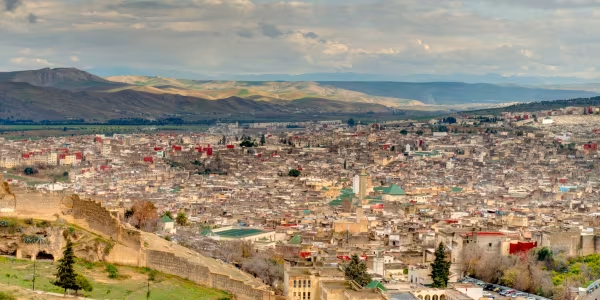
1 – Al-Qarawiyyin Mosque: A Spiritual and Historical Treasure
We begin this Top 10 guide with the Al-Qarawiyyin Mosque, an architectural and spiritual treasure located in the historic city of Fes, Morocco. Founded in 859 by Fatima al-Fihriya, it is considered one of the oldest universities in the world and an important symbol of Muslim culture.
The Al-Qarawiyyin Mosque is renowned for its stunning square-shaped minaret, which dominates the urban landscape of Fes. Its façade is adorned with colorful mosaics and intricate Arabic calligraphy, reflecting the craftsmanship of the time.
Inside, visitors can admire a spacious courtyard and a beautifully decorated patio. The main prayer hall is impressive, featuring marble columns, luxurious carpets, and a finely carved wooden ceiling. Worshippers and students gather here to pray and study the teachings of Islam.
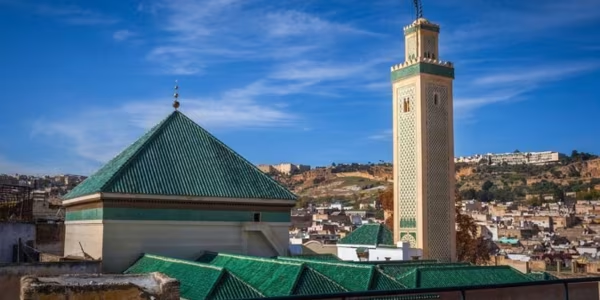
The University of Al-Qarawiyyin, located within the mosque, was the historical center of science and culture in the Arab world, and it played a vital role in Islamic education for centuries. It houses a precious library that contains a vast collection of ancient manuscripts and rare books. Some of these documents date back over 1,000 years, making this library one of the oldest and most significant in the world. The Al-Qarawiyyin Mosque is also a gathering place for worship and celebration during religious holidays, attracting thousands of faithful visitors from near and far.
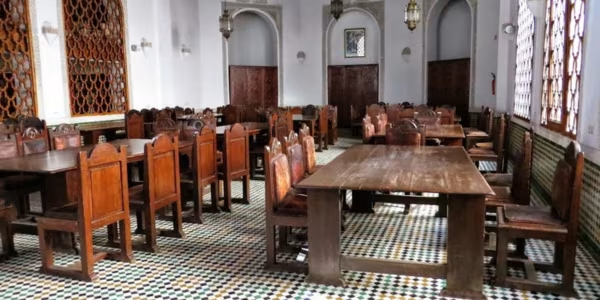
The preservation of the Al-Qarawiyyin Mosque is of utmost importance to Morocco. Continuous efforts are made to maintain its historic architecture and preserve its cultural heritage. The mosque was designated a UNESCO World Heritage Site in 1981, highlighting its universal significance. The Al-Qarawiyyin Mosque in Fes is much more than a place of worship; it is a symbol of the richness of Islamic civilization and the central role that Fes plays in the history of Morocco. Visitors can discover the harmony between art, architecture, and spirituality, while exploring the academic legacy of one of the oldest educational institutions in the world.
Also worth visiting: the Hassan II Mosque in Casablanca, the largest mosque in Africa and the second largest in the world.
2 – Discover the Magnificence of Bab Bou Jeloud During Your Visit to Fes
Bab Bou Jeloud is a beautifully decorated city gate located in the medina of Fes el-Bali, the old city of Fes, Morocco. This impressive gateway was built by the French colonial administration in 1913. Also known as "The Blue Gate of Fes," it is one of the city’s most iconic landmarks. Bab Bou Jeloud stands out for its intricate architecture and vibrant colors. It is adorned with traditional blue and white tiles, giving it a distinctive and elegant appearance. The gate marks the entrance to the medina and the souk, providing visitors with direct access to the lively and bustling heart of Fes. Passing through Bab Bou Jeloud, travelers enter a maze of narrow, winding alleyways filled with artisan shops, bustling markets, and traditional cafés. It’s the perfect place to soak in the authentic atmosphere of the medina and discover the rich culture and traditions of Morocco.
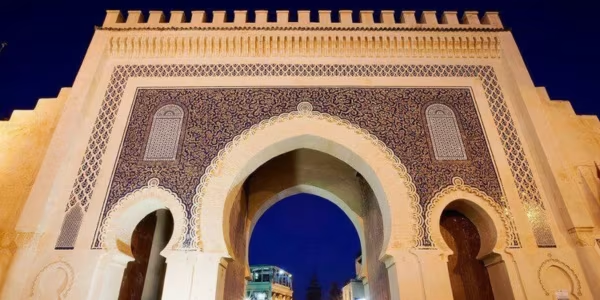
Bab Bou Jeloud is not only a gateway to the medina of Fes, but also a must-see location for photography and admiring the city’s historic architecture. Visitors can stroll along the city walls and take in the beauty of this majestic gate. With its rich history and captivating aesthetic, Bab Bou Jeloud is one of the most popular attractions in Fes. It is a place where travelers can dive into the city's history and soak up its unique charm.
3 – Explore the Wonders of Fes's Ancient Medina: A Journey Through Time
The old city—or medina—of Fes is a true historical gem in Morocco. Considered the largest medina in the world, it has been a UNESCO World Heritage Site since 1981. The medina of Fes consists of two distinct parts: Fes El-Bali, the oldest, dating back to the 8th century, and Fes Jdid, a newer part founded by the Marinids in the 13th century. Fes El-Bali, with its labyrinth of narrow and winding alleyways, offers a real journey back in time. As you wander through its lively streets, you’ll discover architectural treasures such as palaces, mosques, and beautifully decorated fountains. Local artisans continue to uphold age-old traditions, and you can witness their craftsmanship in the workshops where they create unique handmade items such as carpets, pottery, and jewelry.
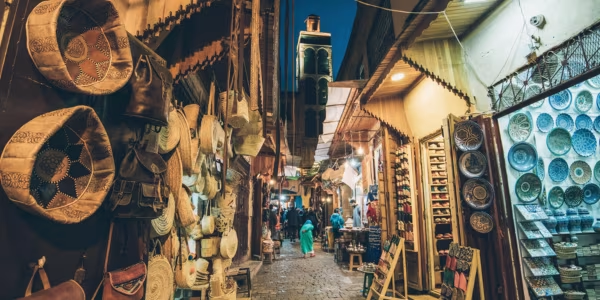
The medina of Fes is also renowned for its souks, where you can immerse yourself in the lively atmosphere of traditional markets. Here, you’ll find a wide variety of goods—from aromatic spices to colorful fabrics and finely crafted leather products. It’s highly recommended to get deliberately lost in the maze of the medina to uncover hidden corners and enjoy a truly authentic experience. As you explore the ancient medina of Fes, you’ll be immersed in a unique atmosphere blending the charm of traditional architecture, the enchanting scents of spices, and the bustle of everyday life. It is a place where history, culture, and local life come together to create an unforgettable experience.
4 – Discover Moroccan Art and Craftsmanship at the Dar Batha Museum: A Cultural Journey in Fes
The Dar Batha Museum in Fes is a cultural gem that deserves a visit during your stay in this historic Moroccan city. Located in a palace of the same name, this ethnographic museum was established in 1915 during the French protectorate in Morocco. Once a splendid royal residence, it now houses an extensive collection of traditional Moroccan arts and artifacts. As you explore the museum's various rooms, you’ll be immersed in the fascinating world of Moroccan craftsmanship.

You will be able to admire hand-woven carpets, finely decorated pottery, sparkling jewelry, embroidered textiles, and other remarkable works of art. Each piece on display reflects the cultural heritage and skill of Moroccan artisans. In addition to its permanent collections, the museum also hosts temporary exhibitions showcasing various aspects of Moroccan art and culture. It’s the perfect opportunity to discover new artistic expressions and to further immerse yourself in the rich cultural heritage of Fes.
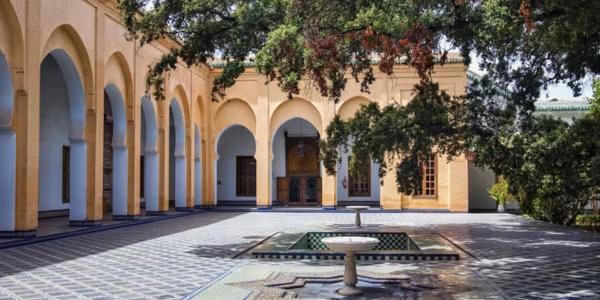
In addition to its captivating interior, the Dar Batha Museum also features a beautiful Arab-Andalusian garden. This picturesque garden is a peaceful space where you can relax and enjoy the beauty of plants, fountains, and mosaics. Whether you are passionate about art, history, or simply curious to discover Moroccan culture, the Dar Batha Museum in Fes is a must-visit stop. Immerse yourself in the rich and enchanting atmosphere of this museum and let yourself be transported to the city’s glorious past.
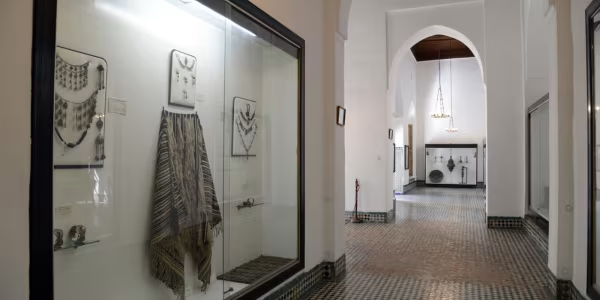
5 – Dar Dbagha in Fes: Dive into the History of an Authentic Fortified Palace
The Fes Tanneries are an iconic site in the medina of Fes, Morocco. It is one of the oldest and largest traditional tanneries in the country, renowned for producing high-quality leather using artisanal methods.
The Fes tannery is a true testament to Moroccan craftsmanship traditions. The tanning process has remained almost unchanged for centuries. It begins with cleaning and preparing the hides, which are then soaked in large vats filled with natural substances such as lime, pigeon droppings, and water. Artisans use their feet to knead and soften the hides, a process that requires great skill and physical endurance
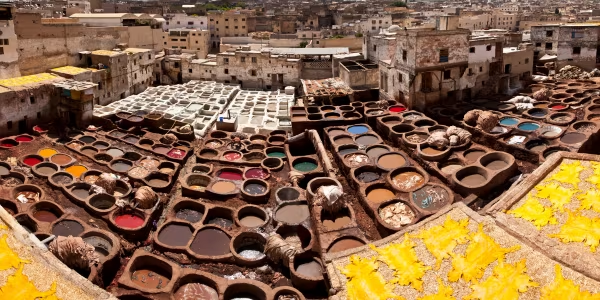
The leather is then dyed using natural dyes such as indigo, saffron, and henna, resulting in rich and varied colors. Artisans hang the hides on the tannery walls to dry in the sun.

During a visit to the Fes tannery, visitors can observe this fascinating process from terraces overlooking the vats, but it is important to note that the smell of the materials used can be very strong. To lessen the odor, visitors are often given sprigs of mint to hold under their noses.
The Fes tannery is a unique site that offers insight into traditional Moroccan craftsmanship and how leather has been made for generations. It is also a place where travelers can purchase high-quality leather goods, including bags, shoes, belts, and other leather accessories.
6 – Médersa Attarine: An Architectural Masterpiece in the Old Medina
The Médersa Attarine, also known as Madrasa al-Attarine, is a religious school located in Fes, Morocco, near the Al-Qarawiyyin Mosque. Built by the Marinid sultan Uthman II Abu Said in the 14th century, it is considered one of the most beautiful Quranic schools in the city.
The Médersa Attarine gets its name from the perfumers who work in the nearby spice and perfume market. It is a remarkable place where students once studied religious and secular sciences. Today, it is open to visitors wishing to explore its magnificent architecture and learn more about the history and culture of Fes.
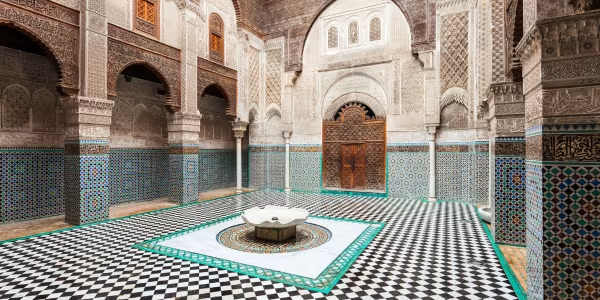
The madrasa is famous for its elegant architecture and harmonious structures. It features exquisite mosaics, finely carved plasterwork, and beautiful original details. Visitors can admire the geometric and floral patterns that decorate the walls, doors, and inner courtyards.

The Médersa Attarine is located in the medina of Fes, a UNESCO World Heritage Site. It offers an immersive experience of Islamic architecture and traditional Moroccan craftsmanship. Visitors can stroll through the study rooms where students once learned and feel the historic and spiritual atmosphere that prevails in this iconic place. Whether you are passionate about history, architecture, or simply want to discover the beauty of Fes, the Médersa Attarine is a must-visit. It reflects the importance of education and the rich cultural heritage of the Kingdom of Morocco.
7 – The Mellah of Fes: A Journey into the Heart of the Historic Jewish Quarter
The Mellah of Fes, also known as the Jewish quarter of Fes, is the city’s historic Jewish neighborhood in Morocco. Located in Fes el-Jdid, the part of Fes that houses the royal palace, the Mellah is rich in history. The Mellah of Fes dates back several centuries and bears witness to the ancient and prosperous Jewish presence in the city. The word “Mellah” means “salt” in both Hebrew and Arabic, and it is said to refer to the salt trade in which the Jews were once involved. Another interpretation relates to the salting of meat according to Jewish traditions.
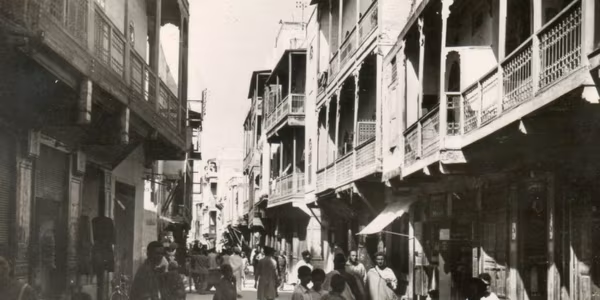
Today, although the Jewish population is relatively small, the Mellah still preserves a number of monuments and places of interest related to the Jewish community. Notably, you can find a synagogue, traditional houses, artisan shops, and restaurants serving local Jewish dishes.
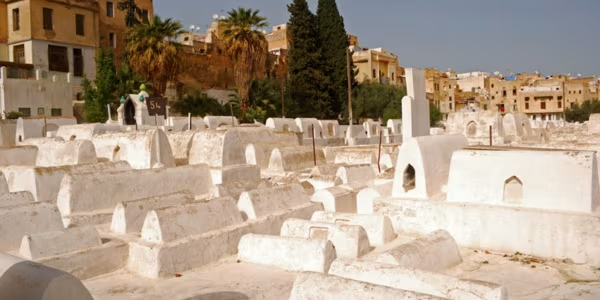
Strolling through the narrow streets of the Mellah offers a fascinating experience, where one can admire the ancient architecture and feel the unique atmosphere of the neighborhood. Visitors can also visit the nearby Jewish cemetery, which bears witness to the history and memory of Fes's Jewish communities. The Mellah of Fes is listed as a UNESCO World Heritage Site and stands as a valuable testament to the multicultural and religious coexistence that has characterized the city over the centuries.
8 – Borj Sud of Fes: A Majestic Fortress Offering Stunning Views of the City
Set out to discover Borj Sud of Fes, also known as the Southern Fortress, an imposing historic structure located in the city of Fes, Morocco. Perched on a hill overlooking the medina, Borj Sud offers breathtaking panoramic views of the city and its surroundings. Built in the 16th century by Sultan Ahmed al-Mansur, Borj Sud was intended to strengthen the city’s defenses against foreign invasions. It was part of a network of fortifications that included other borjs (forts) scattered around Fes.
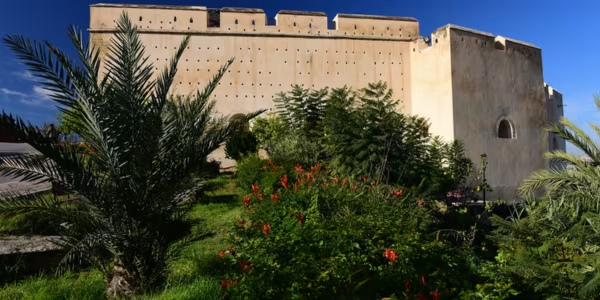
The structure of Borj Sud is impressive, with its thick walls, watchtowers, and bastions. Inside, there are exhibition rooms that trace the history of Fes, museums of art and craftsmanship, as well as spaces dedicated to temporary exhibitions. Visiting Borj Sud is an immersive experience that allows visitors to dive into the region’s history. The various exhibitions highlight the architecture, craftsmanship, Islamic art, and culture of Fes and its surrounding area.
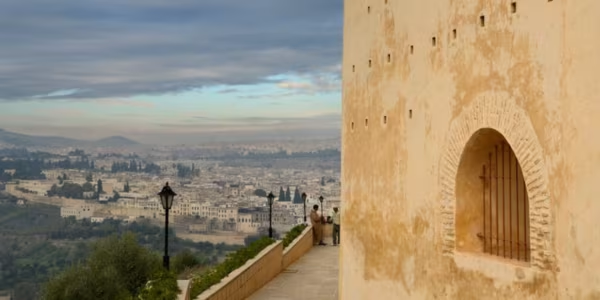
One of the unique features of Borj Sud is its landscaped garden that surrounds the fort. Visitors can stroll along shaded pathways, admire the plants and fountains, and enjoy a moment of peace and relaxation while taking in the magnificent view of the medina. Whether you want to learn more about the history of Fes, admire the impressive architecture, or simply enjoy the panoramic view, a visit to Borj Sud is a must during your stay in the city—especially to watch the sunset.
9 – Médersa Bou Inania: A Treasure of Islamic Architecture to Discover in Fes
The Médersa Bou Inania is an architectural marvel located in the city of Fes, Morocco. Built in the 14th century by Sultan Abu Inan Faris, this madrasa (Quranic school) is a dazzling example of Islamic art and architecture. The Médersa is famous for its magnificent carved wooden entrance door, which immediately offers a glimpse of the splendor inside. Crossing this door, visitors are transported into a world of elegance and refinement.
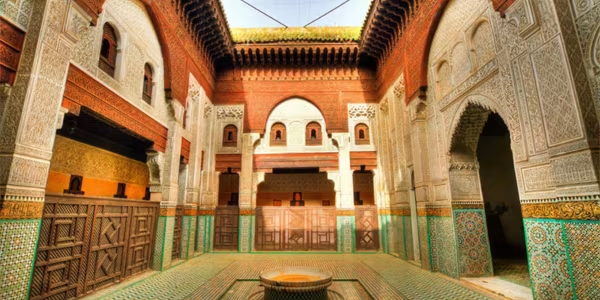
The interior of Médersa Bou Inania is just as impressive, with its paved courtyards, walls adorned with mosaics and finely carved stucco, carved wooden ceilings, and richly decorated study rooms. The complex geometric patterns and Arabic calligraphy create an enchanting atmosphere that reflects the knowledge and spirituality that once prevailed in this institution. The central courtyard is a true masterpiece of Moorish architecture. Finely crafted arches frame the central fountain, creating perfect symmetry and visual harmony. It is an ideal place to relax and recharge, away from the hustle and bustle of the Fes medina.
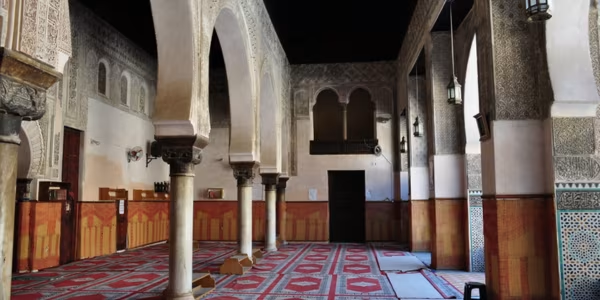
The Médersa Bou Inania was originally a place for religious learning, but today it is open to visitors. Travelers can explore the various rooms, admire the exquisite architectural details, and learn more about the history and culture of Fes.
10 – Discovering the History and Beauty of Fes El Jdid: The Planned District of Fes
Fes El Jdid, also known as Fes el-Jdid, is one of the three parts of the city of Fes, Morocco. Founded by the Marinids in 1276, this area is considered the "new Fes." Unlike Fes el Bali, which is the old, organic medina, Fes Jdid is a planned district. Fes Jdid is home to several sites of interest. The district is famous for its Jewish Mellah, an ancient Jewish community with its own synagogues and traditions. Visitors can explore this historic neighborhood and learn more about the Jewish history and culture of Fes. Another major point of interest in Fes Jdid is the Royal Palace.

This magnificent palace is an example of traditional Moroccan architecture and is still used by the royal family during their visits to Fes. Although visitors are not allowed to enter the palace, they can admire its impressive architecture from the outside. The Great Mosque of Fes el-Jdid is also a site not to be missed. This structure was built as a fortified palace and administrative center. It features magnificent architecture and artistic details that reflect the rich history of Fes.
Also discover Maristan Sidi Fredj, a medical gem of Moroccan history not to be missed
We conclude our Top 10 guide with the Maristan of Sidi Fredj, also known as the Maristan of Fes, a historic maristan located in Fes, Morocco. Founded by the Marinids in the 13th century, it functioned as a medical institution providing care for the sick and the needy. The Maristan of Sidi Fredj is considered the main and most famous maristan in Morocco. It played an important role in the history of medicine in the region. It was renowned for its treatment of diseases and injuries, as well as for its advanced medical research.
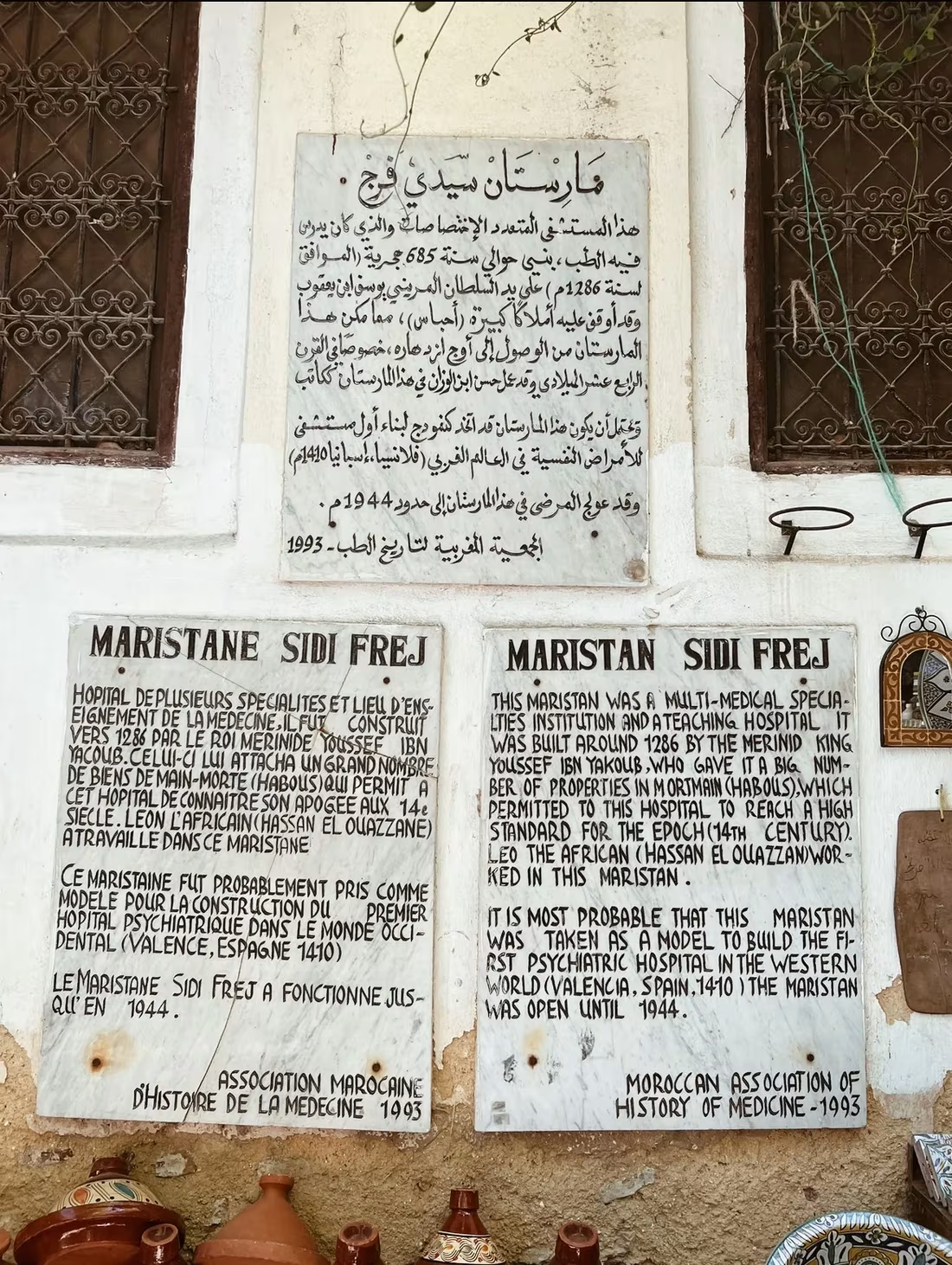
Today, the Maristan of Sidi Fredj is a popular tourist site where visitors can admire the magnificent architecture and learn more about the history of medicine in the region. The square and terrace of the Maristan are particularly charming.
Other places to visit in Fes:
Jnan Sbil Garden
Take weekend excursions to Ifrane and Sefrou around Fes